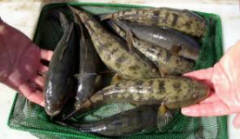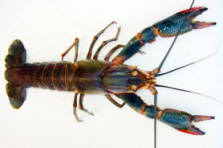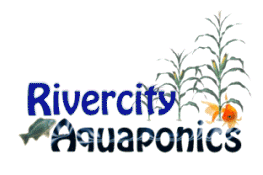Your new aquaponic system should be run for a minimum of 2 weeks before you introduce fish, it can be beneficial to let it run longer if possible. Once your fish are introduced you will see an increased rate of growth in your greens as the nutrient cycle begins to take effect.
You can have fish for consumption or keep ornamental fish as pets, they both do the same job and provide nutrients to the vegetables.
Jade Perch
Jades make excellent candidates for Aquaponics.
They are hardy, grow fast and taste good on the plate.
Jade Perch have the highest level of Omega 3 oils in
any seafood available in Australia. Jades readily accept
pellets and do well on a low protein, high fibre diet.
They are aggressive feeders, and care should be taken to
ensure that all the fish in the tank get fed, not just the
dominant fish in the population. This will help to ensure
even growth. Jade Perch perform best in water 6.5-8.0 pH,
nil ammonia, hardness;80ppm, and temperature 18-32C.
Jades are one of the better growth performers in aquaculture- they can obtain a plate size of 500g in under 12 months (in SE Queensland), if conditions are suitable. Plate size in 18 months is more common and would be what is expected for most aquaponic systems. They can grow to 50cm and 8kg!
The biggest issue with Jade Perch is temperature. Jades stop metabolizing food at water temperatures below 18C, and will start to show stress at 16C, and death at prolonged periods below 14C. During winter, it is important to keep water temperatures above 16C. Jades are susceptible to common diseases that affect most cultured fish, but bacterial and fungal problems are most prevalent in the cooler temperatures, and ectoparasites during the spring and autumn. Most of these health issues can be avoided if water quality is kept at a optimum level and water temperature is maintained above 22C. Jades have a firm, white flesh with a oily texture. They can be smoked, grilled, baked or steamed.
Silver Perch
Silve Perch also make excellent aquaponic subjects. They are
very hardy, and will tolerate water conditions that would kill
many other species. They make excellent starter fish if you
have not kept fish before.
Ideal water parameters are- pH- 6.5-8.0, Ammonia nil, Hardness;
80ppm and temperature12-26C. Silvers tolerate the extremes of
water temperatures better than almost any other aquacultured fish
in Australia, and will grow through about 9 months of the year in
SEQ. Silvers main disadvantage is their slow growth. To get the fish
to a plate size of 500-600g, take 24 months up too 3 years. This is a
long time to maintain and feed the fish in a captive environment.
Silvers will readily accept pellets and do best on a diet similar to Jade Perch- a low protein, high fibre diet.
Silvers generally do not suffer from any major health issues. Silver Perch are a good eating fish, with firm white flesh and a delicate flavour. They are great steamed, grilled, fried or used as a base in Asian Dishes.
Sleepy Cod
Sleepy Cod are not well known as aquaculture species, and despite their appearance are
excellent eating. They are a tropical species and can be difficult to feed.
Ideal Water Parameters- pH- 7.0-8.5, Ammonia – Nil, Hardness > 100ppm and Temperature
25C+.They do not metabolize food below 18C, and stress at 16C prolonged exposure below 16C
can result in death.
They will accept a pellet, although can be frustrating to feed, often requiring several small
feeds a day to ensure that all are fed. They do best on a sinking pellet. They are carnivorous,
and so do best on a high protein diet. Sleepy Cod are considered plate size at 600g+, and due to their body structure, quite small fillets come off a 600g fish. Most Sleepies are presented at 800g-1kg commercially. They can obtain 600g in 18 months if conditions are suitable.
Sleepy Cod present excellently on the table. They lend themselves to all the common methods of cooking.When feeding your fish, a general rule is too feed as much as they can eat in 2-3 minutes. This amount will change as the fish grow and the water temperature changes. If after 3 minutes there is uneaten food in the tank, the fish have probably been fed too much and it is best to remove it before it pollutes the tank.
Murray Cod These are Australia's biggest freshwater fish and have long been a staple in the commercial aquaculture industry. Murray Cod are more difficult to keep than the Silver and Jade Perch, largely due to their aggressive nature and their susceptibility to health problems. Ideal Water parameters for Murray Cod- pH- 7.0-8.0, Ammonia- Nil, Hardness 100 ppm and temperature 12-26C. Murray Cod grow well at 18-22C, but are susceptible to bacterial and fungal issues when water temperatures get over 26C.
Murray Cod are carnivorous in nature, and require a high protein diet.
They can be a little difficult to feed, and often take some training to
get them to readily accept a pellet. They can get to a plate size of
600-800g in 18 months, but 24 months is more common.
One big disadvantage with Murray Cod is their aggressive behaviour towards their tank mates. They are territorial by nature, and will cannibalize. It is important to ensure that all the fish in the tank are offered the opportunity to feed to ensure that not just the dominant fish get fed. Cod will often spar and damage themselves as a result, leaving a area for bacterial and fungal infection.
It is important to grade this fish and keep fish of a similar size together to limit the aggressive behaviour as much as possible. For this reason, it is often necessary to separate the dominant fish in a tank and so several culture tanks may be necessary. Murray Cod have firm, white flesh and provide a chunky fillet. They have a good, distinct flavour, and lend themselves to all the common cooking methods.
Red Claw
Red Claw are omnivorous crustaceans, craylings are not ideal candidates for
an aquaponic system as it does provide the right environment for the to
flourish. However advanced juveniles will thrive, they feed on formulated
pellets and also whole grains. They require feeding approximately three times a
week, feed them just on dusk as this is their natural feeding time.
They require excellent water quality and a water temperature above 23 degrees
celcius. They also require shelters in their tank, they can be as simple as PVC pipe cut offs, or squares of shadecloth. This is particulalry important when they are breeding, so the young have sanctuaries to hide in. It is important not to mix them with predadtory fish as they will become a delicious snack.
Red claw are excellent eating, and are harvested between 300g and 500g. The grow at a rate of 120g per year.
Barramundi
At fingerling size 4cm or an inch in length, kept in a tank, they will attack and eat one another. The larger sized fish will nip and wound smaller fish. You will notice the smaller fry fish swim about the tank with a chunk taken out of their sides. Eventually that fish will die if not eaten by the others.
There is a couple ways of dealing with this problem. Ideally you will need to separate the bigger fish from the smaller. Special cages are designed to allow the smaller fish to swim through the bars and escape the larger predator. The other way is through attrition. Buy a lot more Barramundi fry and expect half of them to be eaten. After all the surviving fish will grow a lot quicker on their high protein diet and you will soon figure out which ones are the cannibals by their increased girth! The third option is to buy your Barramundi as larger juvenile. At around the 10-15cm size the fish will stop eating each other. This is probably the better option but slightly more expensive as larger fish command a higher price.
Barramundi are rapid feeders but along with that benefit comes a problem. What goes in has to come out. Barramundi are big poopers and fouling the water requires adequate system to deal with water filtration. You may find that what works well with tilapia which are a very tough fish species - won't work as well when dealing with Barramundi. Their water requirements are more stringent. You will need lots of dissolved oxygen going into their tank, supplying good aeration. Barramundi need very good water quality in Aquaponics and preferably water temperature between 26degree celcius and 28degrees celcius. An ideal fish for Aquaponics if you live in the tropics. An expensive proposition if you live in a cold climate. Some people prefer to grow Barramundi over the summer months, eat them in Autumn as plate sized fish and then over the cold winter months replace them with cold water fish. Barramundi are a great table fish .
Ornamental Fish
Gold Fish and other ornamentals do very well in aquaponic systems. The variety you choose will dictate the water temperature etc.
Some fish are much hardier than others so choose carefully. We recommend your stock standard gold fish which you can purchase at most pet stores.
You can purchase native fingerlings from the following
or you can purchase ornamental fish from Brookfield Produce
or your local pet supplies store.
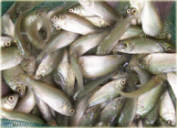
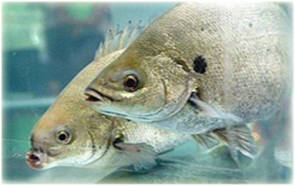
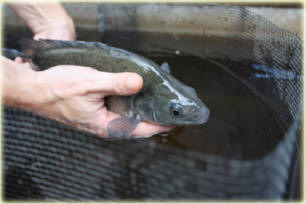

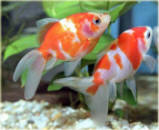
www.seqfish.com.au
